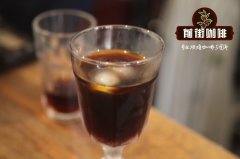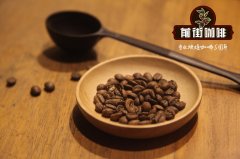Columbia Saint Ario Manor Colombian Coffee characteristics Colombian hand Coffee

Professional coffee knowledge exchange More coffee bean information Please pay attention to coffee workshop (Weixin Official Accounts cafe_style)
This bean has a strong, intense plum acidity on the palate and a slightly honey-sweet finish
Different from ordinary fruit acids, lemons and berries.
As for the taste of ice drops-plum acidity is also very thick, with a bit of wine
Treatment: Washing
Nose: rose, plum, honey, thick
Country: Colombia
Location: Cauca
Garden: Saint Ario's Manor
Elevation: 1950-2050 m
Colombia Finca Santuario
For many years, the Santo Tuario estate has been a leader in the technology and cultivation methods of Colombia's fine coffee plantations, and the soul of this is the estate owner Camilo. Camilo Merizalde was born in Valle del Cauca, Colombia.(Valle de Cauca), who often ran to the coffee garden near his home and watched adults process coffee from childhood until he decided to go to the United States to study after high school. After graduation, he worked as the manager of a Colombia food and beverage factory in the United States and often had the opportunity to return to his hometown of Colombia to purchase green coffee beans. At that time, Camilo began to wonder why the coffee in Colombia often failed to compare with Africa and Central America in quality. Colombia coffee is often thought not to be among the best coffee producing countries. During this period, Camilo began to study and read relevant knowledge and books on coffee cultivation in the United States, hoping to grow fine coffee that would surprise the world. At the same time, Camilo kept looking for a manor with a high quality microclimate environment in Colombia until 2000, when he finally found the most excellent farmland in the department of Cauca, Colombia. At this time, Camilo immediately began to carry out large and small transformation matters in the manor. The ideal coffee farm concept is ready to be realized in this estate named Finca Santuario.
Camilo first decided to improve the soil quality of the estate by planting a large number of ash plants to provide the earth with abundant and natural nitrogen, while retaining many native plants and fruit trees to provide a diversified source of nutrients. Camilo then began to analyze the terrain of the estate and divided it into 266 different micro-blocks, so that the owner of the estate could easily track the growth of coffee and microclimate changes in the estate. The second step was to select the coffee varieties to be planted. Camilo decided at the beginning to choose the low-yield, high-quality native varieties, and finally planted the first Tibica coffee tree in November 2002. Until today, many varieties with excellent cup test performance have been expanded in Santo Ario, such as Tibica, Geisha, Bourbon, Pointy Bourbon, etc. Due to the high altitude of 1,950~2,050 meters, the large temperature difference between day and night and the volcanic ash soil, it is especially suitable for breeding these delicate varieties. The third step is to build its own washing treatment plant and exposure drying room, from its drying room is in Colombia has a lot of very advanced equipment, Camilo first for the drying room on both sides of the installation of large fans, using the principle of fans to accelerate the flow of air, in addition to avoiding excessive fermentation of raw beans can also stabilize the temperature of the exposure room. Camilo, who is full of experimental spirit, has improved the washing equipment in the washing treatment plant through the experience of cooperating with 2015WBC champion Sasa Sestic, and greatly improved the quality stability and sweetness by using the stainless steel bucket and rounded corners.
Camilo's first batch of Santo Ario beans was officially exported in 2005 and has become the preferred partner of many competitors until today. In addition to WBC champion Sasa Sestic, Matt Perger, the 2013 Australia barista champion, praised Santo Ario's beans and won the second place in the WBC World Series by combining them with EK43 bean grinders. Camilo is constantly experimenting with new ways to improve the quality of his coffee in collaboration with these players, and from the annual cup tests more flavor presentations and unique varieties are always found.
Important Notice :
前街咖啡 FrontStreet Coffee has moved to new addredd:
FrontStreet Coffee Address: 315,Donghua East Road,GuangZhou
Tel:020 38364473
- Prev

Costa Rican Tarazu Shepherd Boy Manor Costa Rican Coffee characteristics Costa Rican boutique
Professional coffee knowledge exchange more coffee bean information please follow the coffee workshop (Wechat official account cafe_style) Costa Rica Tarrazu La Pastora SHB Costa Rica Tarazhu Shepherd Boy Manor SHB English name Costa Rica La Pastora Costa Rica Tara Pearl producer Shepherd Boy processing Plant graded European very hard beans (SHB)
- Next

Panama 90 + geisha coffee beans Posi | N2 Panamanian geisha coffee brand geisha coffee special
Professional coffee knowledge exchange more coffee bean information please follow the coffee workshop (Wechat official account cafe_style) description [BlackBerry, dark chocolate, lavender] Panama 90 + geisha coffee beans Posi | N2 (Geisha N2 Perci 90 + NPGE Panama) production area: 90 + NPGE, Panama altitude: 1400 1800 meters raw bean treatment: N2 coffee
Related
- Detailed explanation of Jadeite planting Land in Panamanian Jadeite Manor introduction to the grading system of Jadeite competitive bidding, Red bid, Green bid and Rose Summer
- Story of Coffee planting in Brenka region of Costa Rica Stonehenge Manor anaerobic heavy honey treatment of flavor mouth
- What's on the barrel of Blue Mountain Coffee beans?
- Can American coffee also pull flowers? How to use hot American style to pull out a good-looking pattern?
- Can you make a cold extract with coffee beans? What is the right proportion for cold-extracted coffee formula?
- Indonesian PWN Gold Mandrine Coffee Origin Features Flavor How to Chong? Mandolin coffee is American.
- A brief introduction to the flavor characteristics of Brazilian yellow bourbon coffee beans
- What is the effect of different water quality on the flavor of cold-extracted coffee? What kind of water is best for brewing coffee?
- Why do you think of Rose Summer whenever you mention Panamanian coffee?
- Introduction to the characteristics of authentic blue mountain coffee bean producing areas? What is the CIB Coffee Authority in Jamaica?

